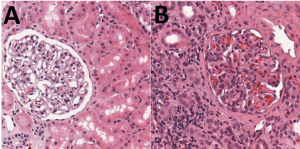Tracking Allograft Outcomes Using High-throughput Whole Protein Analysis
 A strong collaboration between Northwestern University and the Scripps Research Institute has led to significant advancements in genomic and bottom-up proteomic discovery for prediction of peripheral blood signatures to diagnose both acute rejection and renal allograft dysfunction. These efforts are currently funded through both U01 AI084146 and U19 AI063603. Both grants will result in the collection of serial patient samples. These samples will be invaluable in the future, and we believe that a top-down proteomic approach will complement and enrich our current studies. One early experiment for this DBP will compare the proteome of peripheral blood mononuclear cells (PBMCs) from both ‘successful’ transplants and those undergoing acute rejection to determine if specific protein isoforms are better predictors for acute rejection than methods currently in use. This experiment will be performed entirely by top-down proteomics and will benefit greatly from the “TOF Orbitrap” developed in TR&D 2. Since these experiments will rely on the tracking of proteomic profiles of several patients, the robust separations platform presented in TR&D 1 will provide the requisite analytical efficiencies, especially when combined with the integrated command and control software proposed in . As the second largest kidney transplant program in the U.S., and as an active academic program heavily involved in clinical research, particularly in multi-center trials, a close collaboration with the NRTDP seems both intuitive and logical.
A strong collaboration between Northwestern University and the Scripps Research Institute has led to significant advancements in genomic and bottom-up proteomic discovery for prediction of peripheral blood signatures to diagnose both acute rejection and renal allograft dysfunction. These efforts are currently funded through both U01 AI084146 and U19 AI063603. Both grants will result in the collection of serial patient samples. These samples will be invaluable in the future, and we believe that a top-down proteomic approach will complement and enrich our current studies. One early experiment for this DBP will compare the proteome of peripheral blood mononuclear cells (PBMCs) from both ‘successful’ transplants and those undergoing acute rejection to determine if specific protein isoforms are better predictors for acute rejection than methods currently in use. This experiment will be performed entirely by top-down proteomics and will benefit greatly from the “TOF Orbitrap” developed in TR&D 2. Since these experiments will rely on the tracking of proteomic profiles of several patients, the robust separations platform presented in TR&D 1 will provide the requisite analytical efficiencies, especially when combined with the integrated command and control software proposed in . As the second largest kidney transplant program in the U.S., and as an active academic program heavily involved in clinical research, particularly in multi-center trials, a close collaboration with the NRTDP seems both intuitive and logical.
Comments are closed.